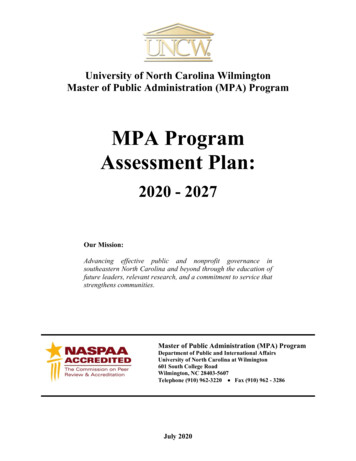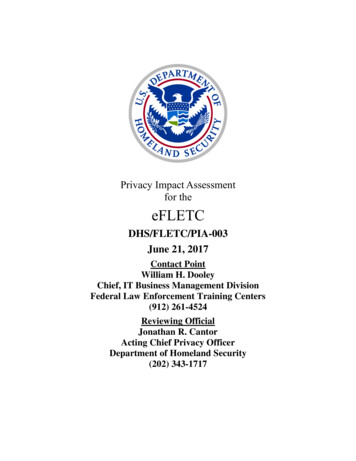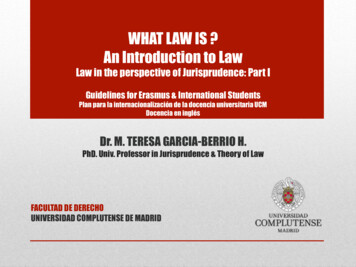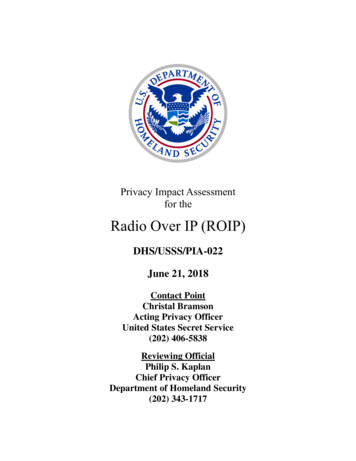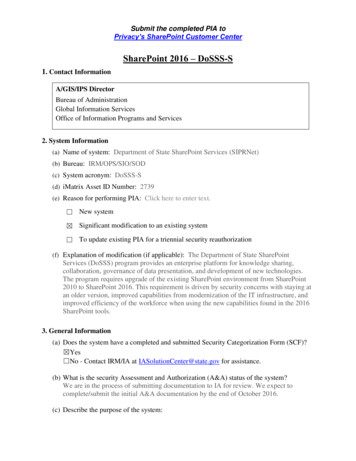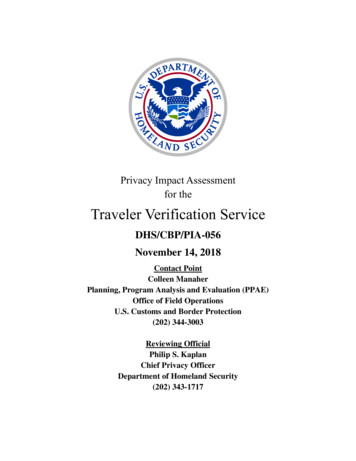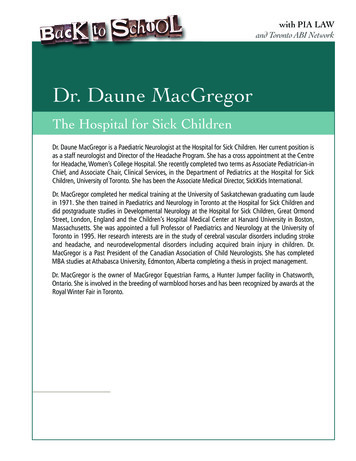
Transcription
with PIA LAWand Toronto ABI NetworkDr. Daune MacGregorThe Hospital for Sick ChildrenDr. Daune MacGregor is a Paediatric Neurologist at the Hospital for Sick Children. Her current position isas a staff neurologist and Director of the Headache Program. She has a cross appointment at the Centrefor Headache, Women’s College Hospital. She recently completed two terms as Associate Pediatrician-inChief, and Associate Chair, Clinical Services, in the Department of Pediatrics at the Hospital for SickChildren, University of Toronto. She has been the Associate Medical Director, SickKids International.Dr. MacGregor completed her medical training at the University of Saskatchewan graduating cum laudein 1971. She then trained in Paediatrics and Neurology in Toronto at the Hospital for Sick Children anddid postgraduate studies in Developmental Neurology at the Hospital for Sick Children, Great OrmondStreet, London, England and the Children’s Hospital Medical Center at Harvard University in Boston,Massachusetts. She was appointed a full Professor of Paediatrics and Neurology at the University ofToronto in 1995. Her research interests are in the study of cerebral vascular disorders including strokeand headache, and neurodevelopmental disorders including acquired brain injury in children. Dr.MacGregor is a Past President of the Canadian Association of Child Neurologists. She has completedMBA studies at Athabasca University, Edmonton, Alberta completing a thesis in project management.Dr. MacGregor is the owner of MacGregor Equestrian Farms, a Hunter Jumper facility in Chatsworth,Ontario. She is involved in the breeding of warmblood horses and has been recognized by awards at theRoyal Winter Fair in Toronto.
Acquired Brain Injury Across the AgesDaune L MacGregor, MD MBASeptember 28, 2017
Pediatric Brain InjuryPlanning for MilestonesPediatric Brain InjuryDaune L. MacGregor:Nothing to Declare and No Conflicts of Interest
Pediatric Brain InjuryGOALS and OBJECTIVES:1.Definitions of Acquired Brain Injury2. Classification of Head Trauma Severity3. Markers of Outcome and Recovery- Imaging- Biomarkers- Functional Connectivity : the Connectome4.Comments about Concussion5. Stages: Acute Hospital Care and Rehabilitation6. Unique Aspects of Pediatric Rehabilitation –Focus on Developmental MilestonesPediatric Brain InjuryElla suffered a terrifying accident when shewas thrown off a horse in July 2015. Thehorse rolled on top of her, causing multipleskull fractures and brain swelling. Ella wasrushed to SickKids and had plastic andneuro surgery treatment. She wasdischarged after only eight days at SickKidsand is still monitored by her doctors. Today,she is continuing with her recovery andrehabilitation , and has made it her missionto fundraise for SickKids.
Pediatric Brain Injury: DefinitionsCanChild (2017)Acquired brain injury is damage to the brain occurring after birth and not related to developmentaldisability, degenerative disease or congenital disorderTraumatic Brain injury is a subtype of acquired brain injury occurring when a sudden trauma causesdamage to the brainAmerican Congress of Rehabilitation Medicine (2010)Traumatic brain injury is defined as an alteration in brain function, or other evidence of brain pathology,caused by external forcePediatric Brain Injury: DefinitionsCanadian Pediatric Society Position Statement (2016)Non-traumatic brain injury infection – meningitis or encephalitisstrokeruptured blood vessels – aneurysm or arteriovenous malformationanoxic (lack of oxygen) – example: near drowningbrain tumorTraumatic brain injury falls bicycle or motor vehicle accidents sports related injuries assault (NAI) – violence penetrating injuries
Pediatric Brain InjuryClassification of Severity of Head Trauma Mild: Glasgow Coma Scale 14 – 15 (75 – 80%) Moderate: GCS 9 –13 Severe: GCS 8Pediatric Brain Injury: Markers of Outcome andRecoveryDiffusion Tensor Imaging (DTI) detects changes in diffusion and assesses direction of water diffusioncan identify microscopic tissue damage and examine white matter tractseven one mild TBI can show damage to white matter tracts (internal capsule, corpus callosum andsubcortical white matter)
Pediatric Brain Injury: Markers of Outcome andRecoverySusceptibility Weighted Imaging (SWI) detection of micro-hemorrhages not seen on conventional MRIlocation of micro-hemorrhaging can be related to patient symptomatologysignificant inverse relationship between GCS and the number and size of hemorrhagic diffuse axonalinjury lesionsPediatric Brain Injury: Markers of Outcome andRecoveryBiomarkers S100BCleaved-Tau Protein (CTP)Neuron Specific Enolase (NSE)Glial Fibrillary Acidic Protein (GFAP)Myelin Basic ProteinUbiquitin C – terminal hydrolase – L1
Pediatric Brain Injury: the ConnectomeThe connectome: traumatic brain injury as a disorder of brainconductivityJP Hayes: J Int Neuropsychol Soc : 22 (2) 120 – 137, 2016Studies examining connectivity (structural and functional MRI methods) in TBI have shown alteredstructural and functional connectivity with decreased integrity of white matter pathways and imbalance andefficiency of functional networks associated with neurocognitive dysfunction and poor outcome. Traumaticbrain injury has a negative impact on distributed brain networks.Use of resting state functional connectivity MRI methodology to examine neural networks disrupted byaxonal injuryLeonhard Euler 1736:“The problem, which I understand is quite well known, is statedas follows: In the town of Königsberg in Prussia there is an islandcalled Kneiphhof, with the two branches of the river Pregelflowing around it.There are 7 bridges--a, b, c, d, e, f, and g—crossingthe two branches.The question is whether a person can plan a walk in such away that he will cross each of these bridges oncebut not more than once.”
Euler, the 7 Bridges of Konigsberg:Graph AnalysisEULER’S APPROACHGRAPH THEORY
Network Science
Intrinsic connectivity (“resting-state”) networksLandmark paper by Biswal in 1995TaskRestBiswal et al., MRM, 1995Bullmore E, Sporns O. Nature Rev Neurosci 2009;186
Intrinsic connectivity (“resting-state”)networksJones et al., Neurology 2013Functional ConnectivityDescribes the relationship betweendifferent brain regions that networktogether to perform a common function
Add Radiol review pic hereBarkhof et al. Radiology 2014;272:29Pediatric Brain Injury: the ConnectomeK. Caeyenberghs: Neuro image 2016 December 3 DOI: 10. 1016/J. Neuro image. 2006. 12. 003TBI is thought to affect cognition and behaviour by changes in functional connectivity. Graph theory is apowerful framework for quantifying topological features of neuroimaging derived functional networks.TBI is associated with hyperconnectivity and suboptimal global integration with increased connectivitydegree and strength. There is reduced efficiency of functional networks (related to diffuse white matterpathology and reductions in grey and white matter volume)
Pediatric Brain Injury: the ConnectomeThe connectome is derived from conductivity maps reflecting distributed brain networks. Micro-structuralchanges can be detected through regional and global properties of these neuronal networks.With healthy neural dynamics, brain regions interact simultaneously maximizing integration andsegregation. TBI represents structural disconnection with axonal injury damaging large-scale connectivitywith the production of impaired cognition, slowed information processing and reduced cognitive flexibility.Pediatric Brain Injury - ConcussionsConcussionThe mildest form of the mild traumatic brain injury usually with temporary symptoms although there isvariation in individuals by duration, onset and type of symptomatology which can be very mild or subtle.Onset can be severe and immediate or delayed. The commonest symptoms are headache, loss of memorysurrounding the event and confusion or disorientation. Concussion can occur without loss ofconsciousness.
Pediatric Brain Injury - ConcussionsSigns and symptoms of a Concussion: headachenauseaproblems with balancedizzinessdrowsinessproblems with sleepsensitivity to lightsensitivity to noiseincreased irritabilitysadnessanxiousnessbecomes “more emotional”Pediatric Brain Injury - ConcussionsConcerns: guidelines for return to play (RTP) persistent postconcussive symptoms (PPCS) recurrent concussions and risk of Chronic Traumatic Encephalopathy (CTE)Consensus Guidelines 2001 - 2016 rest until asymptomatic with graduated return to play approximately five days concern for risk of second impact syndrome increased recommendations regarding physical rest and cognitive rest with limited social interactionJAMA: December 20, 2016:316 (23) 2491 – 2492 prospective cohort study: Predicting and Preventing Postconcussive Problems in Pediatricsenrolled 2413 participants 5 to 17-years old with acute concussion30.4% developed PPCS – 24% in the early physical activity group versus 43.5% in the group thatreported no early physical activityconcluded earlier physical activity after concussion may be associated with beneficial outcomesresolution requires a randomized clinical trial
Pediatric Brain Injury - ConcussionsBiomarkers evaluating sports related concussionsNeurology: February 7, 2017: 88:512 – 513 and 595 – 602 collegiate athletes with preseason plasma tau sampling and cognitive testing46 athletes had sports related concussions with sampling done six hours – seven days with controlsand non-athlete controls compared at baselineboth SRC and athlete controls had significantly higher mean tau at baselineSRC athletes with long RTP had higher tau concentrations over allconcluded elevated plasma tau concentration within six hours following a sports -related concussionwas related to having a prolonged RTP – may be able to identify athletes most at risk for poor recoveryneeding additional monitoring and clinical carewhy do athletes have higher plasma tau? Physical exertion or sub- concussive hits
Pediatric Brain InjuryOutcomes and RehabilitationTBI is a risk for negative impact on brain maturation and development – can be thought of as a developingdisability over time (R. C. Savage IBIA)Critical Factors: The brain in childhood and adolescence is not static but develops with changes in growth, maturationand functioning over time There are different milestones reached at various ages and stages of childhood and adolescence Need to evaluate TBI deficits in relationship to the child’s age and developmental stage time of theinjury and determine functional outcome as well as relationship to affected regions of the brain (brainregions have their own particular stages of growth and maturation). Example – infants and toddlers with fronto-temporal injury appear functionally normal weeks to monthsafter the injury but with brain maturation there are cognitive, behavioural and motor deficits whichemerge.Pediatric Brain InjuryOutcomes and RehabilitationEwing Cobbs (2003): Recovery from severe brain injury may be limited to skills already established Recovery of previously acquired skills may not ensure continued development of new and lateremerging skills – or skills that were in a rapid rate of development at time of injury i.e. deficits followingearly injury associated with disruption to skills in the process of development at the time of injury. Children have limited cognitive reserve (cognitive ability) – little or no prior knowledge or lifeexperiences to use to support recovery including cognitive behavioural functioning and thedevelopment of compensatory strategies
Pediatric Brain InjuryOutcomes and RehabilitationNeurocognitive StallRecognized as part of a second phase of brain recovery – halting or slowing occurring more than one yearafter brain injury affecting later developing stagesInitial recovery curves can be followed by plateaus in functioning and then equivalent declines incomparison to typically developing peersPediatric Brain InjuryOutcomes and RehabilitationNeuro-plasticity Fake news: the brain of the child is resistant to trauma as it is more plastic – that is able to take overfunction for damaged brain regions Fact: neuro-plasticity may help with recovery from focal injuries but the concept does not apply tocomplicated injuries – diffuse or shearing injuries or those involving multiple brain regions Opposing view: following very early injury, rapid developmental changes typical in the preschool period,can result in unlimited neuro- plasticity Fact: Multiple processes can be disrupted (concept of the connectome) by multiple types of injury andmay not be protective but rather result in greater deficits that in comparison to older children
Pediatric Brain InjuryOutcomes and RehabilitationWhat is the extent to which normal development is possible andspite of an early brain insult (A. McKinley): capacity for recovery is not universal to all developmental functionsneuro- plasticity is not the ability to return to pre-injury functionthere will be influences by the type and severity of injury and the child’s environmentearly injury may lead to greater deficitsPediatric Brain InjuryOutcomes and RehabilitationDifferences in Normal Development for Preschool Children There may be no objective information about the child’s functioning prior to injury and evaluation is ofdeficits in potential – not decline in existing function Skills that are assessed represent a reduction in potential – not a reduction in existing skills Absence of deficits does not mean no requirement for rehabilitation support – deficits may becomeapparent over time (skills fail to emerge) Long-term approach and follow-up is needed particularly for times of transition i.e. preschool to school
Pediatric Brain InjuryOutcomes and RehabilitationRecognized Deficits: Infants and Preschoolers with more severe injury – poor adaptive skills and behavioural difficulties (psychosocial functioning andpsychiatric problems in later life), long-term compromise of arithmetic skills with mild TBI requiring hospitalization – ADHD, conduct disorder and substance abuse assessment based on the developmental stage from parent report of preinjury function – need formultiple time point assessments post injurygreatest deficits may be seen in skills at the time of injury which were in developmentlack of communication skills (i.e., preverbal infants) and lack of cognitive and language capacityaffecting child’s understanding of postinjury changes with limited coping skillsPediatric Brain InjuryOutcomes and RehabilitationParental ReactionImportance of the quality of parent – child interaction disrupted by an early injury – parental reaction understress i.e. protective or punitive responsesChildren are reliant on the family system and parental coping for aspects of recovery
Pediatric Brain InjuryConclusions and New Approaches:1. Acquired Brain Injury – a developing disability over time2. Traumatic Brain Injury – a disruption of the connectome and of functionalconnectivityPediatric Brain InjuryConde V, Andreasen SH, Petersen TH, Larsen KB, Madsen K, Andersen KW, Akopian I, Madsen KH,Hansen CP, Poulsen I, Kammersgaard LP, Siebner HR. Alterations in the brain’s connectome duringrecovery from severe traumatic brain injury: protocol for a longitudinal prospective study. British MedicalJournal 2017: 7 (6): pp 1-9.Hannawi Y, Stevens RD. Mapping the Connectome Following Traumatic Brain Injury. Current Neurologyand Neuroscience Reports 2016: 16 (5): 44: pp 1-18.Hellyer PJ, Scott G, Shanahan M, Sharp DJ, Leech R. Cognitive Flexibility through Metastable NeuralDynamics Is Disrupted by Damage to the Structural Connectome. The Journal of Neuroscience 2015: 35(34): pp 9050-9063.Kim J, Parker D, Whyte J, Hart T, Pluta J, Ingalhalikar M, Coslett HB, Verma R. Disrupted StructuralConnectome is Associated with Both Psychometric and Real-World Neuropsychological Impairment inDiffuse Traumatic Brain Injury. Journal of International Neuropsychological Society 2014: 20 (9): pp 887896.Xiao H, Yang Y, Xi J, Chen Z. Structural and functional connectivity in traumatic brain injury. NeuralRegeneration Research 2015: 10 (12): pp 2062-2071.
Dr. Daune MacGregor is a Paediatric Neurologist at the Hospital for Sick Children. Her current position is as a staff neurologist and Director of the Headache Program. She has a cross appointment at the Centre for Headache, Women's College Hospital. She recently completed two terms as Associate Pediatrician-in

